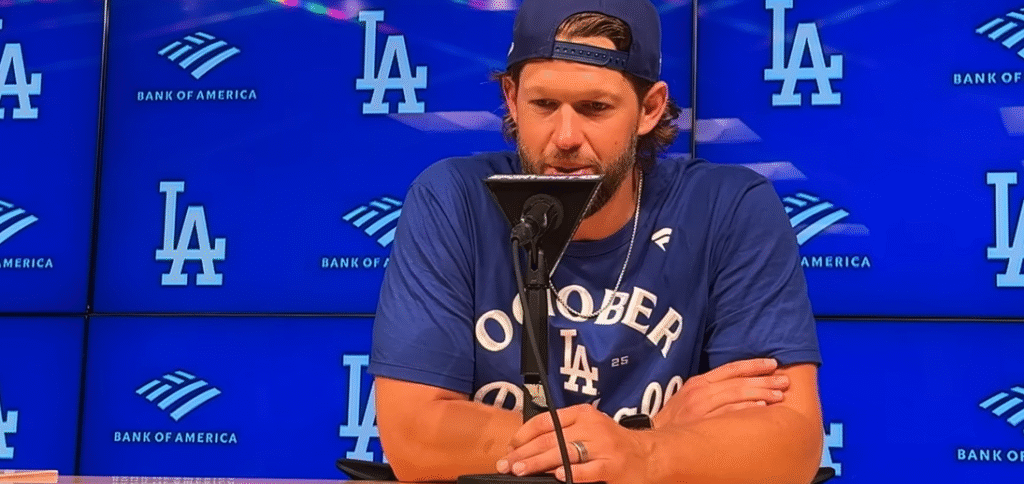The 18 incredible seasons that Clayton Kershaw spent with the Los Angeles Dodgers started in 2008, when he was a daring rookie at the age of 20, and ended in 2025, with his cap raised high to roaring cheers. Few sportsmen exhibit such unwavering devotion, and even fewer maintain their excellence with the same team for almost 20 years. The impact of Kershaw’s tenure with the Dodgers was particularly evident: in a time when rosters were constantly changing and tactics were constantly changing, he was not only the team’s ace but also their heartbeat.
The Dodgers were looking for a new identity when Kershaw came on the scene in 2008. With 21 victories, a 2.28 ERA, and 248 strikeouts, he had already rewritten expectations by winning the pitching Triple Crown in 2011. His first Cy Young Award-winning season was a remarkable way to herald the arrival of a generational talent. Similar to how fans grasped at history being made in front of them, his curveball, which is frequently referred to as unfair, left hitters helpless.
Clayton Kershaw – Career and Personal Overview
| Category | Details |
|---|---|
| Full Name | Clayton Edward Kershaw |
| Born | March 19, 1988 – Dallas, Texas, USA |
| Height/Weight | 6 ft 4 in (193 cm), 226 lb (102 kg) |
| Position | Pitcher (Left-handed) |
| MLB Debut | May 25, 2008 – Los Angeles Dodgers |
| Final Season | 2025 (announced retirement) |
| Years with Dodgers | 18 seasons (2008–2025) |
| Career Strikeouts | 3,052 (20th pitcher in MLB history to reach 3,000) |
| Major Awards | 3× Cy Young (2011, 2013, 2014), 1× MVP (2014), 10+ All-Star selections, Gold Glove, Triple Crown, ERA titles |
| Championships | 2020 World Series Champion, 2024 World Series (injured but on roster) |
| Notable Records | Best career ERA (2.53) of any live-ball era starter with 1,000+ innings |
| Spouse | Ellen Kershaw |
| Philanthropy | Kershaw’s Challenge (charity supporting children and families in need) |
| Reference | Clayton Kershaw – Wikipedia |

He became a study in adaptation over the course of his eighteen years. His legacy might have been destroyed by injuries, velocity declines, and postseason scrutiny, but he continuously reinvented himself and displayed an extraordinarily adaptable toolkit of pitches and tactics. In his later years, accuracy took the place of pure speed, and he produced far more art than fastballs. Kershaw changed his rhythm like a maestro altering his tempo, yet he still overpowered opponents.
Kershaw’s career path bears a striking resemblance to Kobe Bryant’s journey with the Lakers or Derek Jeter’s relationship with the Yankees. Athletes who embodied both athletic prowess and cultural resonance came to represent a single franchise. In a sport where athletes regularly look for new contracts elsewhere, fans found Kershaw to be incredibly dependable. Generations of Dodgers fans were reassured by his presence that their team’s identity was still linked to excellence.
For many, the high point of his career was helping the Dodgers win their first championship in thirty-two years in 2020. His legacy benefited greatly from that World Series victory, which put an end to years of criticism focused on his October struggles. He destroyed a narrative that had unjustly eclipsed his regular-season dominance with every strikeout. More than just a title, that moment represented redemption and a rewriting of history, reflecting the instantaneous way in which sports can alter public opinion.
He had already established himself as a member of the select group of left-handed greats by the time he recorded his 3,000th strikeout in July 2025. In addition to being historic, he reached this milestone much more quickly than many of his peers thanks to unwavering discipline and the kind of consistency that markedly enhanced each rotation he anchored. Although his career lasted longer than Koufax’s, providing nearly two decades of consistent excellence, fans compared his skill to that of legends like Sandy Koufax.
His charitable work off the field gave it a new dimension. His family’s charity, Kershaw’s Challenge, has raised millions of dollars for underprivileged kids and communities. That work effectively demonstrated that athletes, like LeBron James with his educational endeavors or Cristiano Ronaldo with his humanitarian donations, can have an impact outside of stadiums. His generosity strengthened his ties to Los Angeles and made him a beloved pitcher as well as a person.
In 2025, his farewell turned into a show of appreciation. Every stadium appearance felt ceremonial, much like Kobe’s last 60-point performance or Jeter’s walk-off hit. Opponents tipped their caps, teammates embraced him, and supporters viewed every pitch as a moment in time. In his final regular-season game in Seattle, he walked off the mound with his head held high, holding onto the ball and not letting go—a remarkably resilient representation of his unwavering bond with the game.
During his tenure, the Dodgers underwent an equally significant transformation. He joined when the team was rebuilding, and by the time he left, they were among the cultural and economic titans of the sport. His consistent dominance was especially creative because it enabled the team to strike a balance between the dependability of a homegrown legend who set the tone in the clubhouse and large expenditures on players like Shohei Ohtani and Mookie Betts.
